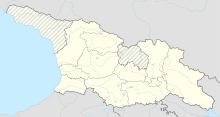Stepantsminda
|
Stepantsminda სტეფანწმინდა |
||
| State : |
|
|
| Region : | Mtskheta-Mtianeti | |
| Municipality : | Qasbegi | |
| Coordinates : | 42 ° 39 ′ N , 44 ° 38 ′ E | |
| Height : | 1,700 m. ü. M. | |
| Residents : | 1,326 (2014) | |
| Time zone : | Georgian Time (UTC + 4) | |
|
|
||
Stepantsminda ( Georgian სტეფანწმინდა ) is a minority (Georgian დაბა , daba ) in the Mtskheta-Mtianeti region in northern Georgia .
The place is located at 1700 m on the Terek River and the eastern foot of the 5047 m high Mount Kazbek in the Greater Caucasus . The historic Georgische Heerstraße , today the international trunk road S3 and European route 117 , which connects Georgia with Russia , runs through the town .
The area was already settled in ancient times. In 1877 a treasure from the 4th to 5th centuries BC was found in Stepantsminda. Found, consisting of silver cups, iron jugs and bracelets as well as statuettes of animals and people.
Stepantsminda (Eng. "Sankt Stephan") is named after the first Christian martyr Stephanus (Georgian Stepan; წმინდა / zminda means "holy"). In 1921 (according to other information in 1925) the place was renamed Qasbegi ( ყაზბეგი ) in honor of Aleksandre Qasbegi (1848-1893), one of the most famous Georgian writers, who was born there . He came from the family of Qasibeg Tschopikaschwili, an area supervisor for the construction of the military road, who had made a contribution to the construction of bridges in the nearby Darial Gorge . Since 2006 the place bears its original name again, the surrounding administrative unit ( municipality ) but still the name Qasbegi ( municipality Qasbegi , Georgian Qasbegis munizipaliteti ).
In the center of the village there is a monument to Aleksandre Qasbegi. The house where he was born was converted into a local museum. In addition to originals of his manuscripts and the antique objects found in 1877, it also shows a saber and a tobacco pipe by Alexander Pushkin , which he used on his trip through Georgia in 1829/30.
Above the village, on the 2170 m high Kwemi Mta ("Lower Mountain"), lies the Gergeti Trinity Church (Gergetis Sameba) , built in the 14th century . The pilgrimage site is connected to Stepantsminda by a road. During the Soviet era , a cable car was built between the village and the church, but was dismantled at the end of the 1980s because believers perceived it as a desecration of the pilgrimage site.
The Betlemi Cave is located at an altitude of 3675 m above Stepantsminda. It was carved into the ice of the Gergeti Glacier by monks in the 10th century and housed a church, monk cells and icons behind an iron-studded wooden door. Legend has it that the Georgian treasury was hidden there during the Mongol occupation in the 14th century.
Web links
- Stepantsminda Municipality: Tourism website (English)



